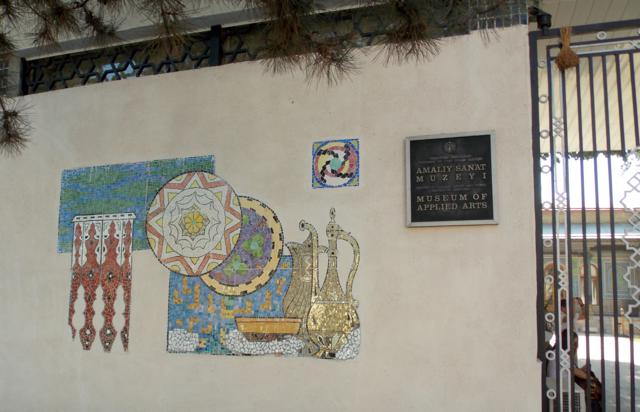Ceea ce atrage atentia inca de la intrarea in curtea muzeului este terasa traditionala deschisa (ayvan), decorata cu nelipsitii stalpi sculptati si tavanul frumos pictat.
In muzeu se pot vedea tesaturile din matase si bumbac, cu modele traditionale:
acoperamantul barbatesc pentru cap:
ceramica din diverse centre:
haine frumos brodate:
cutii si lazi incrustate cu sidef si metal:
mobilier si usi sculptate:
O incapere care atrage in mod deosebit atentia in cladirea muzeului este sala de receptii. Acesta are tavanul frumos decorat cu stalactite si pictat. Mobilierul uzbek pictat este din secolul al XIX-lea.
La iesire, cateva mici magazine cu suveniruri expun marfa de buna calitate asa ca nu trebuie ocolite nici ele.
A museum which we visited as a group in Tashkent was the Applied Arts Museum. The building belonged to a tsarist Russian diplomat, Alexander Polovtsev, who used to be a traditional craftworks collector. He built this house to expose his collection. The museum was inaugurated in 1927. It is open daily between 9-17. The entrance ticket is aprox. 3$ and you have to pay an extra 3500 sum if you want to take photos.The ayvan, an open traditional terrace is the first thing that draws attention when you enter in the courtyard. Inside you may admire traditional silk and cotton textiles, men headgears, ceramics from different centres, embroidered coats, sculpted furniture but especially “suzani”. This means “needlework” and designates cotton pieces of different dimensions and use. Some of them are used to decorate the rooms by hanging on the walls. Suzani are from XVIII-th century but this art was revitalized nowadays due to the tourists interest. It is said that a girl was appreciated as a future wife considering her skills to make suzani. The motifs are mainly floral, but you can see also fruits or birds, the sun and the moon.
A beautiful room is the reception room, wonderfully ornated.
You must not ignore the souvenirs little shops at the exit.


I love all of the color in these photos. The details in the buildings too.
Fantastic all these pictures…..so much lovely colors and details.
Greetings, Joop
Thank you for the comment, Randy!
Thank you for the visit and comment, Joop!
Wow, simply stunning display of art! I love the rich patterns and designs. I would love to have such beautiful robes to wear. My favorite are the two fellows at the end :^) Fantastic presentation TH!
Thank you for the comment, Doug!
A wonderful assortment of enchanting details!
Thanks, VP!
Wonderful shots. Happy WW! I played too. Mine are here and here.
Thank you, Cafe au lait!
Oooo, ce tesaturi fantastice, ce frumusete de culori, de arabescuri si filigrane !!! Cred, ca deocamdata, asta-i postul preferat despre Drumul Matasii Minunata prezentarea !!!
Minunata prezentarea !!!
Sunt minunate atat tesaturile ,cat si obiectele din ceramica,dar mi se par mai deosebite acoperamintele barbatesti pentru cap.Ar trebui sa primesti toate felicitarile din partea acestei tari,a carei cultura si istorie o prezinti,intr-un mod atat de profesionist.Sper ca macar articolele sa le citeasca.
Multumesc, Dani! Muzeele de acest gen imi plac intotdeauna. Ele iti dau o idee despre cultura unui popor si te incanta exact prin ceea ce ai scos tu in evidenta.
Multumesc mult, mircea! Acele obiecte de purtat pe cap sunt deosebite si extrem de variate, atat ca motive folosite cat si ca moment in care sunt purtate.
Just the building is a museum in itself And what a colorful whole. Does not see any place or part which is not tiled or decorated. A bit strange that you need extra betaslen to take pictures!
And what a colorful whole. Does not see any place or part which is not tiled or decorated. A bit strange that you need extra betaslen to take pictures!
In every museum in Uzbekistan you have to pay to take photos. I find it OK, better than not to be aloud to take photos at all, as it is the case in other countries, even European. Thanks for the comment, Helma!
Câtă migală în lucrături … oare cât timp le lua până terminau o piesă …?
Superbe obiecte: tesaturi, imbracaminte, ceramica, bijuterii! Cred ca nu multa lume cunoaste artele decorative din Uzbechistan. Faci foarte bine ca le popularizezi.